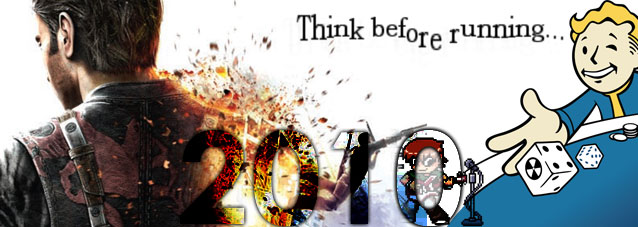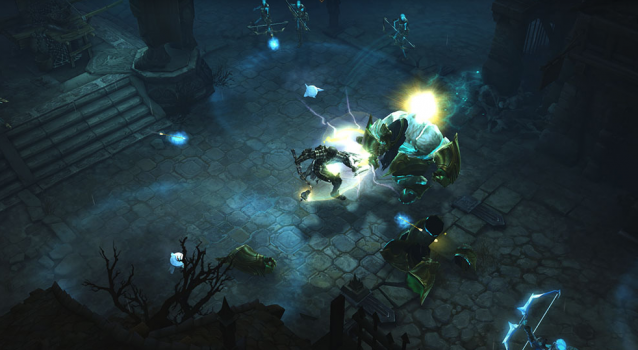

ilomilo is a puzzle game developed jointly by Microsoft Game Studios and SouthEnd Interactive, who previously brought the well-received remake of Lode Runner to XBLA. The goal of ilomilo is to reunite ilo and milo, old friends who have a knack for getting separated from each other. This is accomplished by strategically navigating both ilo and milo through bizarre cube worlds until they are brought back together. It’s an interesting set up, and the game sports a singular visual style, but is ilomilo any fun? Read on for the answer.
The single player campaign mode makes up the bulk of what the game has to offer. It starts off with a few tutorial levels that explain the basic mechanics of the game before moving on to a unique world map system that gives the player freedom in choosing which levels to play. Each world’s levels are positioned in a 3×4 square and can be accessed as long as the player has completed an adjacent level. Each level has the same basic goal of reuniting ilo and milo, but the strategies required to be successful vary slightly between levels, and drastically between worlds.
Players move ilo and milo around the world with the analog stick, pressing the “B” button to switch between ilo and milo, and picking up and placing cubes. Each special cube has its own attributes that greatly affect gameplay. For example, some cubes can be used to fill gaps, and others float up like elevators. These cubes could be compared to the different suits in a Mario game, and are responsible for the only real depth in ilomilo.
The levels themselves are three-dimensional mazes built entirely of cubes that the characters can walk along, with areas that allow players to cross over to the sides and bottoms. This makes for gravity defying movement that utilizes the game’s 3D design to the fullest. However, it also results in frequent problems with the camera. All too often, even with full control of the camera system, the gamer’s view of objects and characters is obstructed by the twisting and turning design of the levels. There is an option to zoom out and around, but doing so often makes it impossible to really see the intricacies of a level’s layout.
One thing the game does get right is the difficulty curve. ilomilo starts off easy and gets progressively harder. The worlds past the halfway mark start to become quite difficult and require dedication to solve. If reuniting ilo and milo isn’t enough of a challenge, completionists will find plenty of other things to do, like finding and collecting three little creatures called Safkas, as well as photos and records. Gamers that enjoy replaying levels will welcome the added challenge, but the average player will have had enough by the time they solve the main puzzle.
ilomilo starts off as a fun and rewarding experience, but quickly turns sour as things become repetitive and the initial uniqueness wears off. The game does not evolve enough to remain captivating, and there is little direction to the levels — players are simply thrown in and told to reunite ilo and milo. This is fine at first, but eventually players will realize that they are spending the majority of their time wandering aimlessly around these strange worlds. Things do change from world to world, but when the only real excitement comes from reaching a new one, it is disappointing to learn that there are only six worlds in the game.
Besides the main single player campaign, there is an unlockable NES-style mini-game called ilomilo shuffle that deserves some recognition. It takes the visual style and gameplay of ilomilo and re-imagines it as an NES classic. It also trades the slowness of the main game for fast-paced old-school excitement. I had more fun trying to get a high score on ilomilo shuffle than I did with anything in the actual game.
Art design and music are ilomilo’s most notable features. The art is slightly reminiscent of LittleBigPlanet, but definitely develops its own unique voice. ilomilo is child-like and chock full of weird creatures and beautiful levels, all of which are displayed in gorgeous graphics that fit the subject matter perfectly. The music is peppy and catchy, but can get a little repetitive. Even so, the soundtrack offers some entertaining tunes that are hard not to hum along with.
Sadly, the off-the-wall story elements don’t fair as well. As the player progresses through the game it becomes evident just how strange things are going to be. When loading screens tell stories about the Cube Painter, who grew six arms in order to paint each cube face at once, or how 211 years ago the cubes got tired of being moved around a decided to become barbers, it can mess with a gamer’s sense of what is normal. Within the right context, weird things and oddities can be a great effect, but in ilomilo’s case it feels forced. Many of the strange story tidbits feel like the result of a developer sitting around in an office wondering how they could make the game feel more “indie.”
The multi-player could have been an entertaining cooperative mode that allowed two players to take on the roles of ilo and milo, respectively, and work simultaneously to bring them together. Instead, what the game offers is an identical copy of the single player adventure that simply splits the duties of controlling ilo and milo. One player controls ilo, while the other player waits with nothing to do until the first player gives up control and switches over to milo, and is left in the same boring predicament.
A good puzzle game is either fast paced and exciting, or strategic and rewarding. ilomilo is not fully either. There is more trial and error than strategy, and there isn’t much of a sense of reward. Moments of brilliance lay within this mostly boring game, but they don’t occur often enough to salvage the experience. As a result, the game can only be recommended to puzzle fanatics who love collecting things and don’t mind a slow paced adventure. Everyone else is advised to pass on ilomilo.
ilomilo is available now on the Xbox Live Marketpace for 800 Microsoft Points.




 SUPERHOT Wiki – Everything you need to know about the game .
SUPERHOT Wiki – Everything you need to know about the game . Five Awesome Ways to Mod Your PS3
Five Awesome Ways to Mod Your PS3 Diablo III: Reaper of Souls Review -- So Great Except for That One Part
Diablo III: Reaper of Souls Review -- So Great Except for That One Part How to get experience, gold and items fast in Diablo 3: Reaper of Souls Ultimate Evil Edition
How to get experience, gold and items fast in Diablo 3: Reaper of Souls Ultimate Evil Edition The Talos Principle (PC, Mac, Linux) review
The Talos Principle (PC, Mac, Linux) review